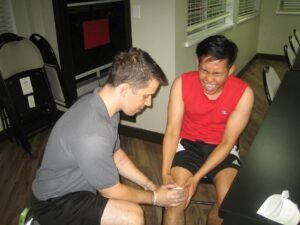An arthritis flare-up is described as an episode of intense pain, stiffness and fatigue. The intense symptoms of arthritis can occur abruptly which can disrupt with the daily routine of the individual.
Depending on the type of arthritis the individual is diagnosed with, flare-ups can be triggered on by overdoing activities, changes to medications, changing weather patterns, stress or without any evident reason at all. There are several measures that can reduce the impact of an arthritis flare-up as well as help recover from one as quickly as possible.
Adequate rest
Even though it seems obvious, those who are suffering from an arthritis flare-up seem to fight it. Remember that rest is vital in order to recover from one. The sore joints should be given time to rest from weight bearing and movement. It is only temporary and can actually allow the individual to resume his/her regular routine sooner than if he/she did not rest at all.

Increasing the pain medication
When analgesic medications are part of the regular treatment regimen, an increase in the dosage can help manage an arthritis flare-up. Understandably, the individual should still follow the directions associated with the medication. Remember that he/she should not take more than the maximum allowable dose. A temporary increase in the medication dosage as long as approved by the doctor can provide relief.
Application of heat or cold
A heating pad can provide a soothing effect and readily available when an individual experiences an arthritis flare-up. Heat works by penetrating the muscles and tissues to stimulate the circulation of blood and reduce the sensation of pain. If there is swelling around a joint, applying a cold pack or ice pack can provide more relief by reducing the inflammation process.
Immobilization of affected joints
Immobilization of a joint using a support or brace can provide relief to the pain. The support or brace relieves pain by providing warmth, stability and compression.
Steroid injection
Another option to manage a flare-up is a steroid injection. This is typically used for pain is that mainly localized and persistent. Take note that a steroid injection is not the first choice of treatment since there are limits on how often an injection is administered. Essentially, many doctors recommend not more than 3 injections on a single joint in a year.
Always have quick meals available
Remember that an arthritis flare-up can last 1-2 days, a week or longer. It is sad to note that a flare can knock an individual off his/her usual pace. In most cases, it is unlikely that he/she feels like cooking until the flare-up subsides.
Having quick meals readily available is vital since you never know when flare-ups can occur, thus it is best to be prepared.
Doctor’s advice
Since arthritis flare-up can occur unexpectedly, the individual should know what the doctor wants him/her to do during one. Consulting a doctor ahead of time is a must. Take note that flare-ups can be inconvenient. It simply means that one can occur during night time or during the weekend when the doctor is not available.
